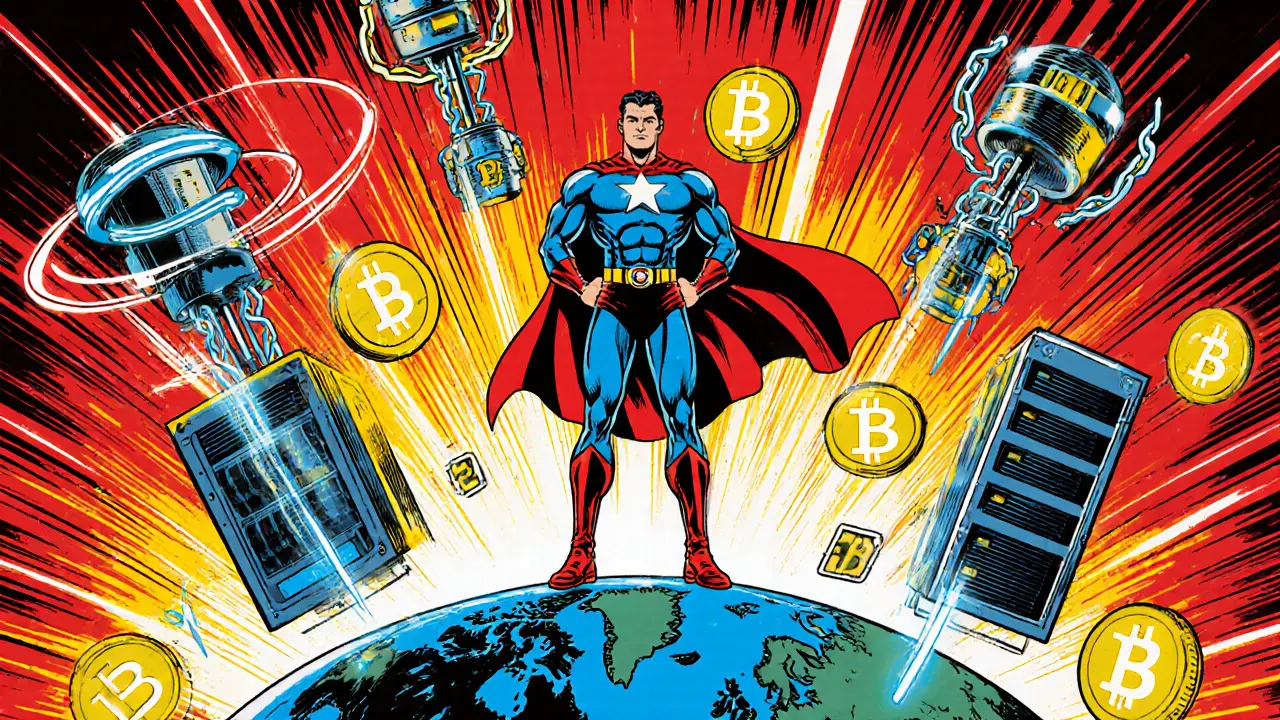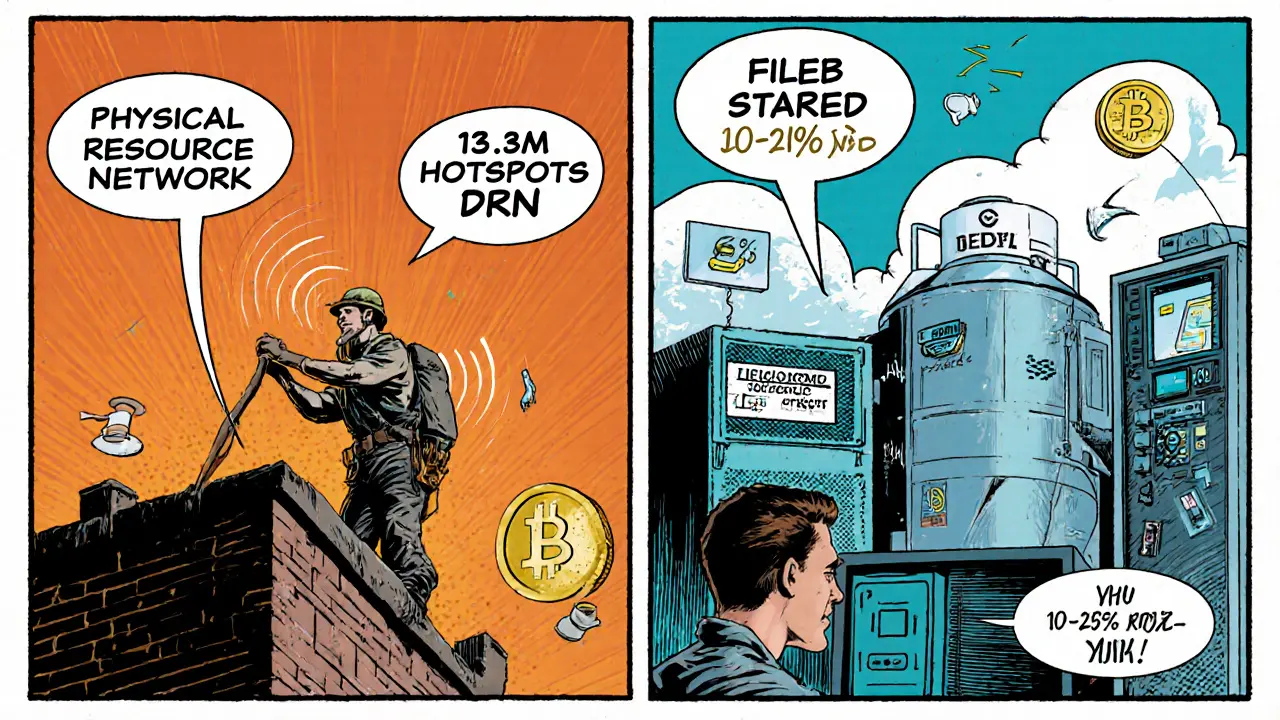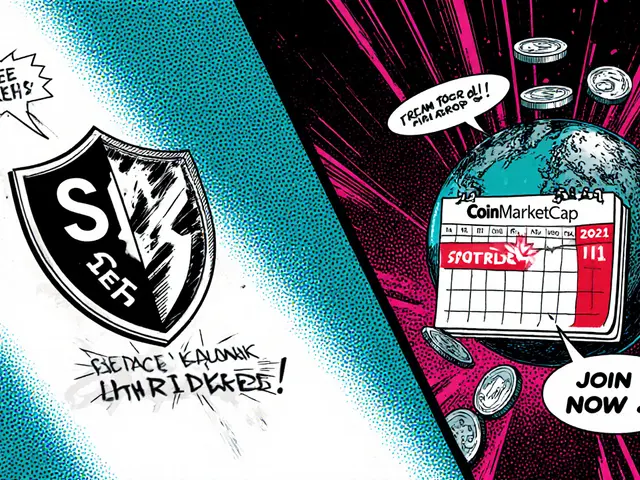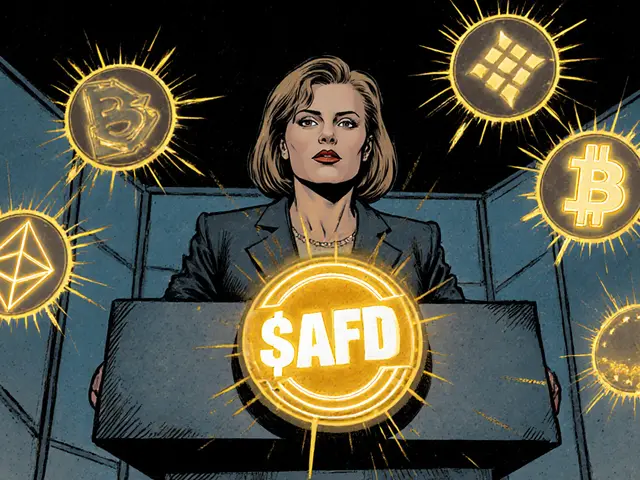
DePIN Investment ROI Calculator
Estimate potential annual returns for DePIN investments based on industry data from the article. Input your investment type and contribution level to see projected returns within the ranges reported for real-world projects.
| Feature | PRN | DRN |
|---|---|---|
| Typical Projects | Helium, Hivemapper | Filecoin, Render Network |
| Hardware Requirement | $100-$1,000 per node | Existing resources |
| ROI Range | 30-40% annualized | 10-25% annualized |
| Risk Profile | Hardware failure, regulations | Token volatility, competition |
Estimated Annual Returns
Investors are hunting for the next big thing that blends real‑world assets with blockchain rewards. DePIN investment has become a hot buzzword, but what does it really mean for your portfolio? This guide walks through the fundamentals, key metrics, risk factors, and a practical framework so you can decide whether DePIN projects belong in your strategy.
What is a Decentralized Physical Infrastructure Network?
Decentralized Physical Infrastructure Networks (DePIN) is a blockchain‑based model that incentivizes real‑world infrastructure creation through tokens, smart contracts, and decentralized applications. In plain terms, DePIN lets anyone earn crypto by installing or sharing physical assets-think Wi‑Fi hotspots, storage drives, or GPU rigs-and letting the network verify that service was actually delivered.
How DePIN Works: The Three Core Components
- Blockchain layer: Most projects launch on Ethereum (a public, permissionless ledger), Polygon (an Ethereum scaling solution offering low fees) or Solana (high‑throughput chain with sub‑second finality). The chain stores token balances, reward calculations, and governance votes.
- Smart contracts: Automated code that validates a service (e.g., a hotspot’s radio signal) and mints rewards. Transaction fees usually sit between 2‑5% of the reward pool.
- Tokenomics: Each project designs its native token to pay participants, fund network upgrades, and sometimes grant governance rights. Sustainable emission schedules-typically under 5% annual inflation after an initial distribution-are a hallmark of successful DePINs.
Two Investment Flavors: Physical vs. Digital Resource Networks
| Aspect | Physical Resource Networks (PRN) | Digital Resource Networks (DRN) |
|---|---|---|
| Typical Projects | Helium, Hivemapper | Filecoin, Render Network |
| Hardware Requirement | $100‑$1,000 per node (hotspot, camera, or antenna) | Existing computing/storage resources; often no extra purchase needed |
| Tokenomics Complexity | Rewards tied to verified physical uptime; higher emission early on | Rewards based on compute cycles or storage GB‑days; usually tiered |
| Typical ROI (first 12months) | 30‑40% annualized for early hotspots; declines as network scales | 10‑25% depending on market demand for storage/compute |
| Risk Profile | Hardware failure, regulatory licensing, cold‑start problem | Token price volatility, competition from centralized cloud providers |

Key Metrics that Matter
Numbers speak louder than hype. Here are the most widely tracked data points for the leading DePINs (all figures as of Q32024):
- Helium - 1.3million hotspots worldwide, 200k active mobile users, average daily HNT reward $0.35 per hotspot.
- Hivemapper - 1.5billion street‑level images collected, 150+ enterprise customers, token price up 12× since launch.
- Filecoin - 15EiB stored, 3.2M active miners, token inflation 3.7% YoY after 2022.
- Render Network - 1.2M GPU jobs processed Q22024, revenue $22M, token reward per GPU hour $0.02.
When evaluating a new DePIN, ask: Is there a verifiable usage metric (hotspots active, GB stored, GPU hours rendered)? Does the token reward correlate directly with that metric?
Risks You Can’t Ignore
Every emerging sector has pitfalls; DePIN is no exception.
- Regulatory uncertainty: Telecom spectrum licenses, energy‑grid compliance, and data‑privacy rules differ by jurisdiction. The US FCC’s 2023 restriction on Helium hotspots cut earnings by roughly 20% overnight.
- Cold‑start problem: Networks need a critical mass of nodes before users see value. Early adopters may earn high rewards that later dilute as the network matures.
- Tokenomics drift: About 60% of DePIN projects tweaked their reward curves within 18months of launch (Messari). Look for transparent governance and capped inflation.
- Hardware reliability: For PRNs, a faulty hotspot or camera can halt rewards. Community surveys report a 30% setup‑failure rate among first‑time Helium miners.
- Market volatility: Token prices can swing dramatically, turning a promising ROI into a loss if you sell during a trough.
Investor Evaluation Checklist
- Real‑world usage data: Verify API‑exposed metrics (e.g., daily hotspot count, stored petabytes, GPU minutes rendered).
- Token utility beyond speculation: Does the token grant network access, governance, or essential fee payment?
- Emission schedule: Prefer projects with <5% annual inflation after the initial distribution period.
- Regulatory landscape: Check whether the project has secured necessary licenses in the target regions.
- Community and support: Active Discord/Telegram, documented SDKs, and responsive dev‑ops teams are good signs.
- Diversification strategy: Balance PRNs (higher ROI but hardware risk) with DRNs (lower entry cost, higher competition).
Applying this checklist to a project like Helium, you’ll see strong usage metrics but heightened regulatory risk. Filecoin scores high on utility and lower hardware risk, yet faces fierce competition from traditional cloud providers.

Future Outlook and Catalysts
Industry forecasts paint an optimistic picture, albeit with caveats.
- Gartner predicts 20% of new infrastructure deployments will incorporate decentralized elements by 2026, up from 5% in 2023.
- a16z Crypto envisions DePIN capturing 5‑10% of global infrastructure value ($500B‑$1T) by 2030 if current growth rates hold.
- Polkadot’s upcoming DePIN parachain slots (total $45M) will likely bring new projects into the ecosystem, increasing competition but also expanding the total addressable market.
- Regulatory clarity-e.g., the FCC’s 2024 guidelines for shared spectrum-could unlock a wave of hotspot deployments in underserved rural areas.
- Technical upgrades like Helium’s migration to Solana (Q42024) aim to cut transaction fees by 80%, making small‑scale participation more profitable.
However, Delphi Digital warns that 70% of current DePINs may merge or fail by 2025, leaving a concentrated top‑tier that will dominate market share.
Key Takeaways
- DePIN blends blockchain incentives with real‑world assets, opening a novel asset class.
- Focus on projects that provide transparent, verifiable usage metrics and have a sustainable token emission model.
- Balance the higher upside of Physical Resource Networks against their hardware and regulatory risks.
- Keep an eye on upcoming scaling solutions (Solana, Polkadot parachains) and regulatory updates that could shift the risk‑reward balance.
- Use the checklist above to conduct a disciplined due‑diligence process before allocating capital.
Frequently Asked Questions
What exactly is a DePIN token used for?
A DePIN token typically serves three purposes: paying transaction fees on the underlying blockchain, rewarding participants who provide physical or digital resources, and granting governance rights so holders can vote on network upgrades.
Do I have to buy hardware to invest in DePIN?
No. You can simply buy the native token on an exchange and earn a share of network fees. However, many investors choose to run a node or hotspot to capture higher, on‑chain rewards.
How risky is regulatory compliance for projects like Helium?
Regulatory risk is one of the biggest uncertainties. In the U.S., the FCC has the authority to limit spectrum usage, which can instantly cut rewards. Investors should monitor local licensing news and favor projects that have already secured permits.
Can I combine DePIN exposure with traditional crypto assets?
Absolutely. Many portfolios allocate a small percentage (5‑10%) to DePIN tokens alongside Bitcoin, Ethereum, and DeFi tokens to diversify across utility‑driven and financial‑only use cases.
What timeline should I expect before seeing meaningful returns from a hotspot?
Early adopters saw 30‑40% annual returns within the first six months, but as the network scales, earnings per hotspot tend to drop 50‑70% over the next year. Patience and a focus on high‑density locations help maintain profitability.






There are 10 Comments
Hari Chamlagai
DePIN isn’t just a trendy buzzword; it’s an evolution of how incentives align with tangible services. The token economics must be scrutinized beyond hype because inflation can erode returns quickly. Look at the hardware uptime metrics – if a hotspot only reports 50% availability, the reward curve will reflect that. Regulatory hurdles are real; the FCC’s recent crackdown on unlicensed spectrum shows that compliance costs can spike overnight. Finally, diversify your exposure across both PRN and DRN layers to hedge against sector‑specific volatility.
Kyla MacLaren
i think its a cool idea
Della Amalya
Reading through the metrics, it’s clear that real‑world usage drives token value more than speculative hype. The Helium hotspot count, for instance, directly correlates with network coverage and thus token utility. When you see a project publishing daily API stats, that transparency is a green flag. Don’t forget to weigh the hardware maintenance costs against the projected rewards. In short, let the data guide your allocation, not the headlines.
shirley morales
DePIN projects claim decentralization but often hide centralized control behind opaque governance structures. They lure investors with lofty promises yet fail to disclose who truly holds the keys to the reward mechanisms. If you cannot audit the smart contracts, you cannot trust the tokenomics. In my view, many of these schemes are more about hype than substance.
Isabelle Graf
Honestly, the hardware cost barrier is huge for most folks. If you can’t afford a hotspot, you’re out of the game.
Shane Lunan
The ROI numbers look slick but ignore the churn rate of devices. Many users bail after the first payout cycle. So take those percentages with a grain of salt.
Bruce Safford
Someone’s not telling you about the hidden backdoor in the smart contract code.
We’ve seen similar patterns in other “decentralized” projects where the dev team can mint tokens at will.
Stay vigilant and audit before you commit.
Blue Delight Consultant
When we contemplate the philosophical underpinnings of DePIN, we must first acknowledge the symbiotic relationship between physical infrastructure and digital incentive structures. The token, in this context, serves not merely as a speculative asset but as a mechanism for aligning individual effort with collective utility. It is essential to recognize that the reliability of a hotspot or storage node is a function of both engineering robustness and economic motivation. Therefore, a well‑designed emission schedule is paramount; unchecked inflation undermines the incentive to maintain hardware, leading to network degradation. Moreover, regulatory compliance cannot be an afterthought; spectrum licensing, data privacy statutes, and energy regulations impose real costs that directly affect ROI calculations. A comprehensive due diligence process should therefore include a review of the project’s legal counsel and jurisdictional exposure. In terms of metrics, the daily active node count, average uptime percentages, and verified service delivery logs provide concrete signals of network health. These quantitative measures must be juxtaposed with qualitative assessments of governance transparency, such as open‑source code audits and community voting mechanisms. It is also prudent to evaluate the diversification of token utility-whether the token is used solely for rewards or also for governance, fee payment, or access to premium services. The latter diversifies demand and can buffer price volatility. Finally, investors should consider the macro‑economic environment; the broader crypto market’s sentiment often magnifies or mitigates project‑specific risks. By integrating these multifaceted considerations, one can arrive at a nuanced appraisal of DePIN investment potential.
Wayne Sternberger
The formal approach to evaluating tokenomics is commendable, yet I must point out a few spelling oversights in the original article. It’s crucial to maintain precision when discussing “inflation” versus “inflationary pressure.” Additionally, the phrase “hardware failure, regulatory licensing, cold‑start problem” could be formatted as a list for clarity. Overall, a solid foundation, but attention to detail will enhance credibility.
Michael Grima
Wow, the ROI charts are as dazzling as a fireworks show-if only they didn’t explode on you when you try to cash out.
Write a comment
Your email address will not be published. Required fields are marked *